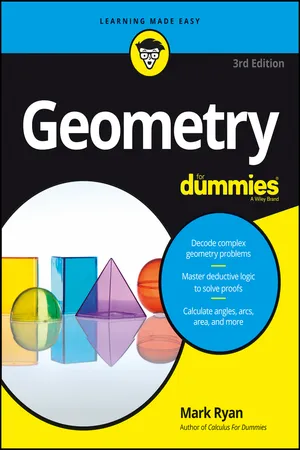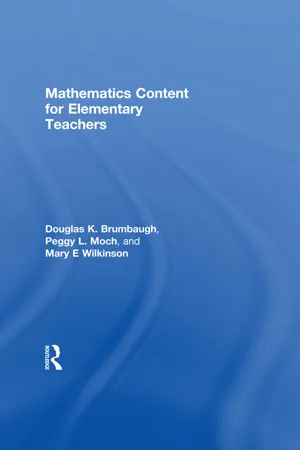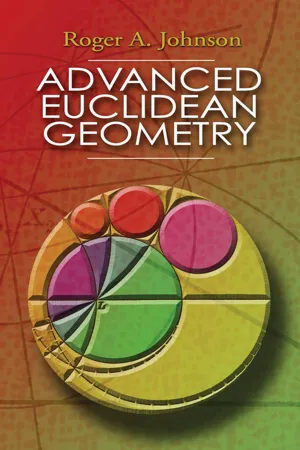Mathematics
Quadrilaterals
Quadrilaterals are four-sided polygons with various properties and classifications. Common types of quadrilaterals include squares, rectangles, parallelograms, trapezoids, and rhombuses. They are characterized by their angles, side lengths, and diagonal properties, making them a fundamental concept in geometry.
Written by Perlego with AI-assistance
Related key terms
6 Key excerpts on "Quadrilaterals"
- eBook - ePub
- Mark Ryan(Author)
- 2016(Publication Date)
- For Dummies(Publisher)
Part 4Polygons of the Four-or-More-Sided Variety
IN THIS PART … Get to know the many types of Quadrilaterals. Work on proofs about Quadrilaterals. Solve real-word problems related to polygons. Work on problems involving similar shapes.Passage contains an image Chapter 10
The Seven Wonders of the Quadrilateral World
IN THIS CHAPTER Crossing the road to get to the other side: Parallel lines and transversals Tracing the family tree of Quadrilaterals Plumbing the depths of parallelograms, rhombuses, rectangles, and squares Flying high with kites and trapezoidsIn Chapters 7 , 8 , and 9 , you deal with three-sided polygons — triangles. In this chapter and the next, you check out Quadrilaterals, polygons with four sides. Then, in Chapter 12 , you see polygons up to a gazillion sides. Totally exciting, right?The most familiar quadrilateral, the rectangle, is by far the most common shape in the everyday world around you. Look around. Wherever you are, there are surely rectangular shapes in sight: books, tabletops, picture frames, walls, ceilings, floors, laptops, and so on.Mathematicians have been studying Quadrilaterals for over 2,000 years. All sorts of fascinating things have been discovered about these four-sided figures, and that’s why I’ve devoted this chapter to their definitions, properties, and classifications. Most of these Quadrilaterals have parallel sides, so I introduce you to some parallel-line properties as well.Getting Started with Parallel-Line Properties
Parallel lines are important when you study Quadrilaterals because six of the seven types of Quadrilaterals (all of them except the kite) contain parallel lines. In this section, I show you some interesting parallel-line properties.Crossing the line with transversals: Definitions and theorems
Check out Figure 10-1 , which shows three lines that kind of resemble a giant not-equal sign. The two horizontal lines are parallel, and the third line that crosses them is called a transversal. - eBook - ePub
- Sandra Rush(Author)
- 2017(Publication Date)
- Research & Education Association(Publisher)
p = 5 + 15 + 5 + 15 = 40. Answer choices (A) and (B) are the lengths of the sides, and answer choice (C) didn’t double the sides to find the perimeter.Square
Now we come to the most restrictive, but also the most popular, quadrilateral—the square. A square is a parallelogram with four equal angles and four equal sides. It can also be thought of as a rhombus with four equal angles or a rectangle with four equal sides.Therefore, the square has all of the properties of the parallelograms mentioned above, as shown in the following table.Properties of the SquareSince a square is a rectangle with equal sides, its perimeter is and its area isProperty of the square: Same as property for: Opposite sides are parallel Parallelogram All sides are equal Rhombus All angles are equal Rectangle Diagonals bisect each other Parallelogram Diagonals are perpendicular to each other Rhombus Diagonals have equal lengths Rectangle Example 6.10.The value of x in the quadrilateral below isA. 55° B. 110° C. 50° D. cannot be determined because they cannot be equal(A) 55°. All of the angles in a quadrilateral total 360°. So we haveAnswer 6.10.The problem is to find the value of x, not 2x. Also, unless you are told what a figure is, don’t assume it is what looks like it is. This figure looks like a trapezoid, but it isn’t. Answer choice (D) is true for a trapezoid, but not this figure, which is just a quadrilateral, as the problem states.Which of the following characteristics of a square is enough to prove that a quadrilateral is a square and not just a parallelogram, rectangle, or rhombus? A. All of the sides are equal. B. The opposite sides are parallel to each other. C. The adjacent sides are perpendicular to each other. D. The diagonals are equal and perpendicular bisectors of each other.Example 6.11.Answer 6.11.(D). Only a square has all three - eBook - ePub
Polygons Galore
A Mathematics Unit for High-Ability Learners in Grades 3-5
- Dana T. Johnson, Marguerite M. Mason, Jill Adelson(Authors)
- 2021(Publication Date)
- Routledge(Publisher)
- I am thinking of a closed shape with four sides where no two of the sides are the same length. What could the shape be? (Trapezoid or dart)
- Ask students to create a graphic organizer showing the relationships of the various types of Quadrilaterals. You may suggest a Venn diagram or tree diagram format. This can be done as a whole-class discussion or done independently by groups. Two examples are included: Venn Diagram of Quadrilateral Relationships (Teacher Resource 2) and Flow Diagram of Quadrilateral Relationships (Teacher Resource 3).
- Have students store their pieces in their sandwich bags, then complete Lesson Summary (Handout 2F) and discuss.
epub:type="title"> Assessment
- Observations (class discussions, partner work); probe for understanding of properties of Quadrilaterals
- Quadrilateral Sorting Table (Handout 2D)
- Lesson 2 Summary (Handout 2F)
epub:type="title"> Notes to Teacher
- The plural of rhombus is either rhombuses or rhombi.
- Some geometric terms such as trapezoid and kite have slightly different definitions in different parts of the world. The definitions given in Handout 2E are the traditional definitions used in textbooks in the United States.
- Sometimes students think that a diagonal can only be inside of a polygon. However, in a concave polygon such as a dart, it may fall outside the quadrilateral as shown in Figure 2.1 .
Figure 2.1.External diagonal of a concave polygon.
- Many students have only seen Venn diagrams as two overlapping circles that are used in a “compare and contrast” activity. The use of Venn diagrams in this lesson where some sets of shapes are entirely contained within another set might be a new idea for students.
- eBook - ePub
- Douglas K. Brumbaugh, Peggy L. Moch, MaryE Wilkinson(Authors)
- 2004(Publication Date)
- Routledge(Publisher)
® and we encourage the use of a dynamic software application as you do this exercise. You may complete the sketches using a straightedge and protractor, but it will be a lot more work. Draw and label polygons with the given characteristics. Name the polygons based on the letters at their vertices, and based on their characteristics. Choose from these terms, using each term only once: acute triangle, equilateral triangle, isosceles triangle, obtuse triangle, parallelogram, quadrilateral, rectangle, rhombus, right triangle, scalene triangle, and trapezoid.a) Three sides with as many right angles as possible. b) Three sides with as many obtuse angles as possible. c) Three sides with as many acute angles as possible. d) Three sides with no sides the same length. e) Three sides with two sides the same length. f) Three sides with all three sides the same length. g) Four sides with no sides the same length. h) Four sides with two opposite sides parallel and the other two opposite sides not parallel. i) Four sides with as many right angles as possible. j) Four sides with all sides the same length and as many obtuse angles as possible. k) Four sides with opposite sides parallel and as many acute angles as possible.In addition to sides and vertices, polygons have other important parts. In Fig. 4.16 , one diagonal of parallelogram DCBA is shown as a dashed segment. The requirements for a quadrilateral to be a parallelogram are that opposite sides are equal in length, denoted as and , and opposite sides are parallel, denoted by and . There are special parallelograms, as shown by the quadrilateral family tree in Fig. 4.14 , but DCBA is a general parallelogram. Trace parallelogram DCBA on a piece of paper and cut it out. Cut along the diagonal from A to C and compare the two polygons you have made.Fig. 4.16.If you repeat this experiment with a few different parallelograms—including rectangles, rhombi, and squares—you can form a conjecture about the relations between parallelograms and triangles. You might trace DCBA again and repeat the experiment using diagonal BD. Although you do not need a formal definition of diagonal of a parallelogram to conduct and understand this experiment, you definitely must know what a diagonal is. - eBook - ePub
- Roger A. Johnson(Author)
- 2013(Publication Date)
- Dover Publications(Publisher)
projective. For instance, we see that in general projective figures are not similar; properties involving ratios and angles are not projective properties of a figure. On the other hand, any relationship involving concurrence of lines and collinearity of points is projective.The theorems of the last three sections have established the fact that the cross-ratio of four points on a line is projectively invariant, and is equal to the corresponding double ratio for the sines of the angles between the projecting rays. This is fundamental in projective geometry.We shall not explore the domain of projective geometry, except occasionally to survey it from the frontier which it shares with our field. We owe the concept of the line at infinity to projective geometry; but for the most part, since the familiar relations of distances, angles and ratios are not invariant in that study, we have little in common with it. Occasionally, as in Chapter XIII , we shall note theorems which are projective in nature; and the concept of a harmonic set of points or lines will sometimes be useful to us.QUADRANGLES AND Quadrilaterals89. Let us establish a few definitions and conventions concerning polygons, especially Quadrilaterals.Definitions. A simple quadrangle or quadrilateral is a closed polygon with four vertices and four sides. The connectors of the pairs of vertices not already connected are the two diagonals.A complete quadrangle is the figure determined by four points in general position, and their six connectors. Two connectors not having in common any one of the given points are called opposite; there are three such pairs, and the points of intersection of opposite connectors are called diagonal points.A complete quadrilateral is the figure composed of four lines in general position, and their six points of intersection. There are three pairs of opposite points, whose connectors are the three diagonals. - eBook - ePub
- Gary Thorne(Author)
- 2015(Publication Date)
- Crowood(Publisher)
To construct a square using a compass, draw the base of AB of the required square. Erect the perpendiculars at A and B, then placing the compass on A, establish AB and draw a quarter arc to intersect the perpendicular at D. In order to confirm correct intersections, place the compass on B, using the established length AB, plot a quarter arc to intersect the perpendicular at C (not shown).A rectangle is a four-sided figure with equal opposite sides and its angles all right angles. Opposite sides and all angles being equal; diagonals from the corners are equal yet where they intersect the angles are not 90 degrees.A quadrilateral form is bound by four straight lines; when opposite sides are parallel it is a parallelogram. A quadrilateral can be a:1. Rectangle: all angles are at right angles. 2. Square: if the sides are equal. 3. Rhombus: if all sides are equal yet angles are not right angles. 4. Trapezium: only two of the sides are parallel. Quadrilaterals and polygons.PolygonsPolygons are plane figures consisting of more than four sides. When sides are equal they are called regular polygons. Polygons include:
QUADRANTS AND CIRCLES5. Pentagon: five sides 6. Hexagon: six sides 7. Heptagon: seven sides 8. Octagon: eight sides. The quadrant is a segment of a circle with a right angle at centre of the curve. The half circle has the radius of the circle forming the diameter line. The circle has a centre point. Radials can be drawn from the right angle point of a quadrant at degrees of 15, 30, 45, 60, 75 and 90 to form a quarter circle. This is established through using 45 degree and 30/60 degree set squares and a T-square.A quadrant, half circle and circle.ANGLES An acute angle is less than a 90 degree angle. An obtuse angle is greater than 90 degrees. It must be less than 180 degrees.A quadrant.The supplement of an angle is the remaining degrees which when added equals 180 degrees. ABC (overleaf) is 110 degrees. Therefore the supplement to this angle is 70 degrees. The complement of an angle is the remaining degrees which when added together form 90 degrees. 70 degrees and 20 degrees = 90 degrees.
Index pages curate the most relevant extracts from our library of academic textbooks. They’ve been created using an in-house natural language model (NLM), each adding context and meaning to key research topics.





